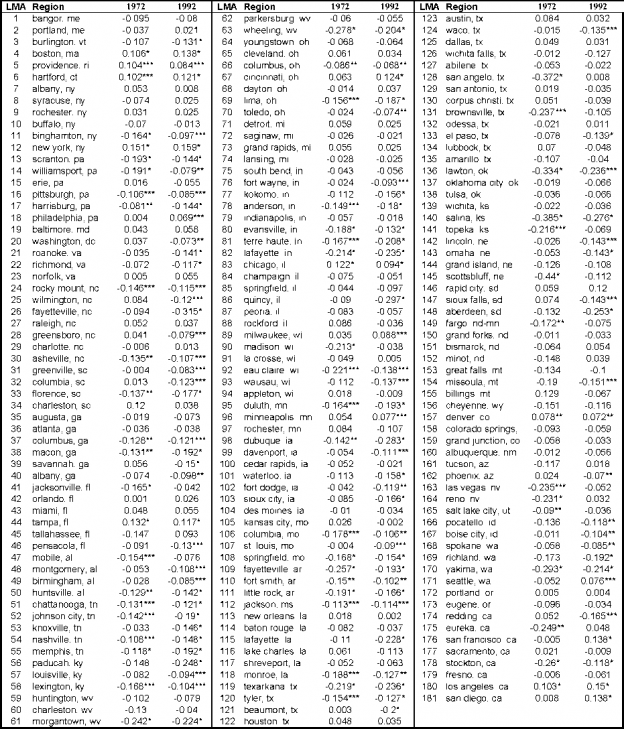As is well known, the LRD only collects wage information on two categories of workers, production and non-production. However, we avoid the usual criticism that dividing workers into production and non-production groups imperfectly classifies them according to skill as our methodology is robust to unobserved differences in regional factor quality. More important for our purposes is that any imperfections in the allocation of workers to production and non-production categories be similar across regions within an…
In this section we consider econometric issues that may cause us to mistakenly reject RFPEQ. Product misclassification can cause us to reject RFPEQ spuriously. To see why, suppose that industry i comprises two goods, j and k, and that good j is non-production worker intense relative to good k by a factor of n*r (e.g. stylish dress shirts versus ordinary dress shirts).15 In addition, to keep things simple, assume there are no factor quality differences…
Second, we test RFPEQ by estimating equations 13 and 14 for all industry and region-pair combinations. We start by choosing a region to be the benchmark, i.e. 7B = 1. Then we run a regression of the form: or where the dr ’s are region dummies that equal one whenever region r is the independent variable. Testing whether the afB’s are jointly equal to zero provides a test of the null hypothesis of a single…
Solving for the input-output ratios in terms of the ratio of observed factor inputs in the two regions, we get Rearranging terms, we can write the observed factor inputs in terms of the observed unit factor requirements, Under the maintained hypothesis of RFPEQ, we can solve for the relationship between the observed factor ratios by equating the relative wages paid to the true labor inputs across the regions, yielding In words, the observed, unadjusted, input…
The previous section has detailed testable implications of relative factor price equality across regions. It is still possible for absolute factor price equality to fail even if RFPEQ holds. Factor-independent productivity shifters will leave relative factor prices unaltered but change the levels of the factor rewards for all factors. In this section we consider the testable implications of FPEQ. The relationship between rewards for a given factor across regions is given by Again the regional…
Now allow RFPEQ to fail so that the relative wage of quality adjusted non-production workers is 50% higher in region r (y _ 1.5) and to simplify the argument let a non-production worker in region r be equal to one third of a non-production worker in region s. From equation 11, we can see that observed relative non-production wages will be 50% lower in region r even though it is a region with high true…
Conversely, equation 10 implies that region r uses relatively fewer non-production workers than region s. These ratios might incorrectly lead one to assume that RFPEQ fails across these two regions and that region r has higher true relative wages. Without extra information on relative factor quality, neither observed wages nor observed factor quantities can help us disentangle the problem of RFPEQ versus differing input quality. To tackle this problem, we use data on both wages…
We start by developing the testable implications for relative factor price equality. Absent any ability to correctly adjust for factor quality differences, the observed relative labor wages in the two regions will be given by Under RFPEQ, the observed relative wages will only equal the true relative wages if the quality adjustments are the same for the two labor types across regions. For observed demands of the two labor types by the industry in the…
While we will make use of the theorems in looking for deviations from factor price equality (FPEQ) and relative factor price equality (RFPEQ) across regions within the US, the theory and empirical methodology can be applied to any tests of factor price equality. To develop our empirical framework, we impose some additional structure in the form of restrictions on the class of production functions. We restrict our analysis to the class of CES production technologies.7…
We now turn to a more formal examination of factor price equality across economic regions.6 We introduce the theorems that motivate our empirical framework and develop the testable implications of the theory under a relatively general set of assumptions. We start by restating the Factor Price Equality theorem of Leamer (1995) which provides the basis for our null and alternative hypotheses: Proposition 1 The Factor Price Equality Theorem (FPEQ). Regions producing the same mix of…




